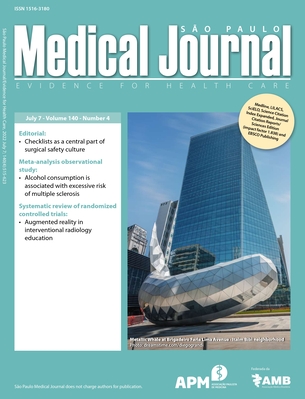Intermediate-term follow-up of laparoscopic pectopexy cases and their effects on sexual function and quality of life
a cross-sectional study
Keywords:
Pectopexy, Prolapsus, Laparoscopic surgeryAbstract
BACKGROUND: Apical prolapsus refers to downward displacement of the vaginal apex, uterus or cervix. Pelvic organ prolapse (POP) can significantly affect women’s daily activities and sexuality. OBJECTIVE: To investigate, at the mid-term follow-up after laparoscopic pectopexy surgery, whether this procedure improved the patients’ quality of life and sexual function. DESIGN AND SETTING: In this cross-sectional study, data on patients who underwent laparoscopic pectopexy in the Gazi Yasargil Education and Research Hospital were evaluated. METHODS: Thirty-five patients with symptomatic apical prolapse and POP quantification stage II and higher were included in this study. We used the Turkish version of the female sexual function index (FSFI) questionnaire to assess preoperative and postoperative sexual dysfunction, and the Turkish version of the Prolapse Quality of Life Questionnaire (P-QOL) to evaluate the severity of POP and its impact on quality of life. RESULTS: The mean age, parity and length of follow-up of the patients were 36.08 ± 9.04 years, 4.00 ± 1.86 and 28.88 ± 5.88 months, respectively. The most common complications were de novo rectocele in three patients (8.6%) and de novo cystocele in two patients (5.7%). All the FSFI and P-QOL scores were statistically significantly improved in the postoperative period (P < 0.001 for all scores of both FSFI and P-QOL). CONCLUSION: The quality of life and sexual function of the patients who underwent laparoscopic pectopexy were found to have become statistically improved at the midterm follow-up. Laparoscopic pectopexy was found to be a viable, effective and safe procedure.
Downloads
References
Masenga GG, Shayo BC, Rasch V. Prevalence and risk factors for pelvic organ prolapse in Kilimanjaro, Tanzania: A population-based study in Tanzanian rural community. PLoS One. 2018;13(4):e0195910. PMID: 29694427; https://doi.org/10.1371/journal.pone.0195910.
Beer M, Kuhn A. Surgical techniques for vault prolapse: a review of the literature. Eur J Obstet Gynecol Reprod Biol. 2005;119(2):144-55. PMID: 15808370; https://doi.org/10.1016/j.ejogrb.2004.06.042.
Nygaard IE, McCreery R, Brubaker L, et al. Abdominal sacrocolpopexy: a comprehensive review. Obstet Gynecol. 2004;104(4):805-23. PMID: 15458906; https://doi.org/10.1097/01.AOG.0000139514.90897.07.
Maher C, Feiner B, Baessler K, Schmid C. Surgical management of pelvic organ prolapse in women. Cochrane Database Syst Rev. 2013(4):CD004014. PMID: 23633316; https://doi.org/10.1002/14651858. CD004014.pub5.
Banerjee C, Noé KG. Laparoscopic pectopexy: a new technique of prolapse surgery for obese patients. Arch Gynecol Obstet. 2011;284(3):631-35. PMID: 20941503; https://doi.org/10.1007/s00404-010-1687-7.
Rosen R, Brown C, Heiman J, et al. The Female Sexual Function Index (FSFI): a multidimensional self-report instrument for the assessment of female sexual function. J Sex Marital Ther. 2000;26(2):191-208. PMID: 10782451; https://doi.org/10.1080/009262300278597.
Wiegel M, Meston C, Rosen R. The female sexual function index (FSFI): cross-validation and development of clinical cutoff scores. J Sex Marital Ther. 2005;31(1):1-20. PMID: 15841702; https://doi.org/10.1080/00926230590475206.
Beer M, Kuhn A. Surgical techniques for vault prolapse: a review of the literature. Eur J Obstet Gynecol Reprod Biol. 2005;119(2):144-55. PMID: 15808370; https://doi.org/10.1016/j.ejogrb.2004.06.042.
Nygaard IE, McCreery R, Brubaker L, et al. Abdominal sacrocolpopexy: a comprehensive review. Obstet Gynecol. 2004;104(4):805-23. PMID: 15458906; https://doi.org/10.1097/01.AOG.0000139514.90897.07.
Sarlos D, Kots LV, Ryu G, Schaer G. Long-term follow-up of laparoscopic sacrocolpopexy. Int Urogynecol J. 2014;25(9):1207-12. PMID: 24700356; https://doi.org/10.1007/s00192-014-2369-y.
Noé KG, Spüntrup C, Anapolski M. Laparoscopic pectopexy: a randomised comparative clinical trial of standard laparoscopic sacral colpo-cervicopexy to the new laparoscopic pectopexy. Short-term postoperative results. Arch Gynecol Obstet. 2013;287(2):275-80. PMID: 22945837; https://doi.org/10.1007/s00404-012-2536-7.
Noé KG, Schiermeier S, Alkatout I, Anapolski M. Laparoscopic pectopexy: a prospective, randomized, comparative clinical trial of standard laparoscopic sacral colpocervicopexy with the new laparoscopic pectopexy-postoperative results and intermediate-term follow-up in a pilot study. J Endourol. 2015;29(2):210-5. PMID: 25350228; https://doi.org/10.1089/end.2014.0413.
Bagli I, Tahaoglu AE. Pregnancy outcomes after laparoscopic pectopexy surgery: A case series. J Obstet Gynaecol Res. 2020;46(8):1364-1369. PMID: 32483826; https://doi.org/10.1111/jog.14337.
Sarlos D, Brandner S, Kots LV, Gygax N, Schaer G. Laparoscopic sacrocolpopexy for uterine and post-hysterectomy prolapse: anatomical results, quality of life and perioperative outcome-a prospective study with 101 cases. Int Urogynecol J Pelvic Floor Dysfunct. 2008;19(10):1415-
PMID: 18536861; https://doi.org/10.1007/s00192-008-0657-0.
Leruth J, Fillet M, Waltregny D. Incidence and risk factors of postoperative stress urinary incontinence following laparoscopic sacrocolpopexy in patients with negative preoperative prolapse reduction stress testing. Int Urogynecol J. 2013;24(3):485-91. PMID: 22825418; https://doi.org/10.1007/s00192-012-1888-7.
Chan CMY, Liang HHX, Go WW, To WW, Mok KM. Laparoscopic sacrocolpopexy for uterine and posthysterectomy prolapse: Anatomical and functional outcomes. Hong Kong Med J. 2011;17(4):301-5. PMID: 21813899.
Bojahr B, Tchartchian G, Waldschmidt M, Schollmeyer T, De Wilde RL. Laparoscopic sacropexy: a retrospective analysis of perioperative complications and anatomical outcomes. JSLS. 2012;16(3):428-36. PMID: 23318069; https://doi.org/10.4293/108680812X13462882736132.
Liang CC, Lin YH, Chang YL, Chang SD. Urodynamic and clinical effects of transvaginal mesh repair for severe cystocele with and without urinary incontinence. Int J Gynecol Obstet. 2011;112(3):182-6. PMID: 21238966; https://doi.org/10.1016/j.ijgo.2010.09.011.
Vitale SG, Caruso S, Rapisarda AMC, et al. Biocompatible porcine dermis graft to treat severe cystocele: impact on quality of life and sexuality. Arch Gynecol Obstet. 2016;293(1):125-131. PMID: 26193956; https://doi.org/10.1007/s00404-015-3820-0.
Helström L, Nilsson B. Impact of vaginal surgery on sexuality and quality of life in women with urinary incontinence or genital descensus. Acta Obstet Gynecol Scand. 2005;84(1):79-84. PMID: 15603572; https://doi.org/10.1111/j.0001-6349.2005.00668.x.






